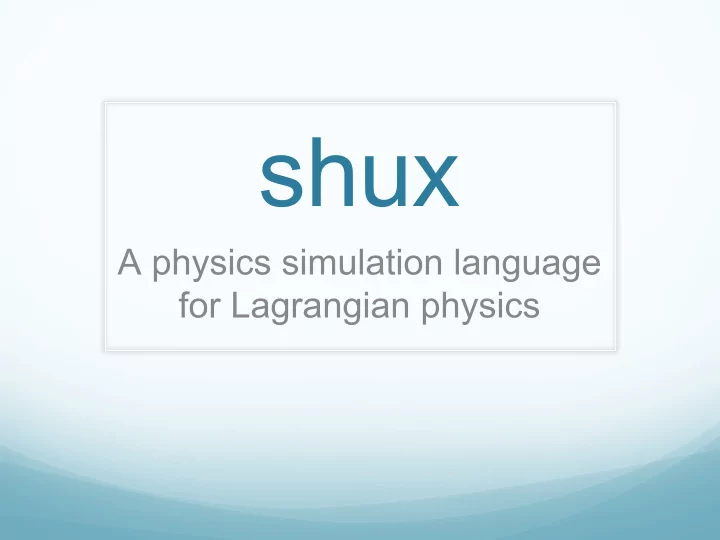

shux A physics simulation language for Lagrangian physics
Our Team ● Lucas S chuermann: Manager, physics dude ● John H ui: Language guru ● Mert U ssakli: Code slave ● Andy X u: System architect
Inspiration Growing field of particle-based numerical physics solvers ● Fluid dynamics ● Granular flow ● Deformables
Main features ● Everything good about C, redesigned for easy implementation of particle-based Lagrangian physics solvers ● Mostly immutable (unless you cheat) types for concurrency ● Simple functional syntax ● Maps, filters, lambdas ● Namespaces ● Lookback and generators ( what are those?! ) ● Easy bindings to OpenGL through extern declarations
Immutability int x = 1; var int y = 2; y = 3; /* this is OK */ x = 5; /* this is not OK */ Allows for guaranteed safety in concurrent settings!
Map! kn addOne(int x) int { x+1 } kn main() int { int[5] x = [1,2,3,4,5]; int[5] xPlusOne = x @ addOne; 0 }
Filters kn lessThanThree(int x) bool { x < 3 } kn main() int { int[5] array = [2,3,4,5,6]; int[] filtered = array :: lessThanThree 0 }
λ s (low key type inferred) kn main() int { int[5] x = [1,2,3,4,5]; bool[5] b = x @ (int i) -> { i % 2 == 0 } }
Namespaces ns constants = { ns physical_params = { let vector <2> grav= (0.0, -9.81); } ns = solver_params = { let scalar dt = 0.001; } scalar y = constants -> physical_params -> grav[1]; }
Everything is an expression int y = 2 int x = if y == 2
The lookback feature and generators gn fib() int { int y = (y..1 : 1) + (y..2 : 1); y } kn main() int { int fib5 = do 5 fib( ); 0 }
Native LLVM OpenGL Binding extern graphics_init(); extern graphics_loop(scalar[] points_buf); kn main() int { graphics_init(); ... graphics_loop(...); 0 }
LLVM<>OpenGL Implementation Excerpt
LLVM<>OpenGL Simple Demonstration
Workflow ● To get all of this working in LLVM, we implemented a pipeline with several layers of translation. ● Goal is to convert code with semantics most distant from C as close as possible to C before generating LLVM IR.
How Crazy Were We? See next slide...
Parser .shux Scanner AST SAST semant CAST LLVM LLAST OpenGL
AST
SAST
CAST
LLAST
Case Study: Lookback gn bar(int a, int b) int { int x = a + x..1 : 3; int y= b + y ..2 : 2 ; x+y } struct gn_bar = { int ctr; int[2] a; int[2] b; int[2] x; int[2] y; } kn bar(struct gn_bar gns) int { gns.x[gns.ctr] = gns.a[gns.ctr] + (ctr <= 1) ? gns.x[(gns.ctr-1)%2] : 3; gns.y[gns.ctr] = gns.b[gns.ctr] + (ctr <= 2) ? gns.y[(gns.ctr-2)%2] : 2; gns.x[gns.ctr] + gns.y[gns.ctr] }
Testing Environment
Testing Environment ● A large suite of automated unit tests were used to thoroughly test every semantic aspect of the language ● When changes were made to frontend or code was added for lower level translations, the suite was run ● Over 150(!) tests allowed us to rigorously verify syntax and steps through CAST generation.
The Good News: What Works We have a fully implemented: ● Frontend ● Semantic checker ● AST to SAST translation ● SAST to CAST translation ● CAST to LLAST… (to be continued) ● Translation from LLAST to LLVM
Frontend � ● Fully tested and robust parser ● Handles a number of edge cases discovered through tests ● Completed very early on in development to ensure testing further down the line
Semantic Checker � ● shux has a strict type checking system, but at the same time maps, filters and generators, expressions complicate type-checking ● Lambdas have type inference ● The goal for the strict type system was readability and ease of translation ● semant.ml is 719 lines of OCaml ● Lookback values are an exception to the rule ● int x = x..1; /* accessed while being defined */
AST to SAST � ● Makes all types in all expressions explicit. Important for translating an expression-based language. ● Does heavy-lifting for further stages of translation ● Lookback values ● Hoisting declarations above expressions in functions and lambdas ● Get rid of option types. ● Separating semantics: ● kernel calls vs generator calls ● float operands and int operands
SAST to CAST � @John the orator
CAST to LLAST � @John the orator
LLAST To LLVM � ● All the LLVM binding specific usage is abstracted in previous levels of translation ● Hide the registers from levels above ● Only operate on stack variables ● Passing by reference in LLVM ● Array ● String ● Structs ● Using global namespace
The Bad: Or, The Perils of Ambition: Real-World Tests � ● Multi-stage pipeline led to many, many, many blocking portions of development or propagating work from changes ● Time was spent fleshing out an amazing sheer volume of code ● We fell a bit sort on demos to show because we were more focused on designing, implementing, and testing a full pipeline
Future Work ● Testing and bugfixes for last two stages of the pipeline, relating to: ● More fully compiled complex usages of the language to generate results ● Finishing filters ● More robust standard library: further graphics calls, gridding, vector operations baked in (dot, matmul, etc)
make_sure_you_start_early.png
Recommend
More recommend